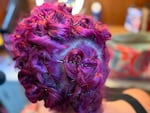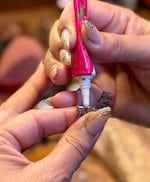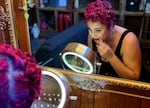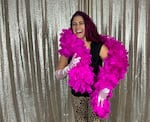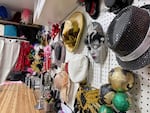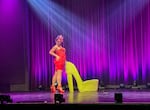
On the first night of the Oregon Burlesque Festival, performer Eva D'Luscious takes the stage for a high heel shoe-themed solo act on Sept. 20, 2024.
Mia Estrada / OPB
On a warm Friday night in September, a crowd gathered in Northeast Portland’s Alberta Rose Theater. Old friends hugged and greeted each other, the din of laughter and big band tunes mixed with ice clinking into glasses at the bar. Tables and racks displayed sparkly apparel for sale in the lobby. Gradually the audience settled into the theater as a recorded voice played over ‘70s music:
”Good evening, and welcome to the Oregon Burlesque Festival. We invite you to make your way to your seats, as the show is about to begin…”
The annual event started in 2013, after the sultry, centuries-old art form saw a modern revival in the Pacific Northwest. This year, the festival presented a two-night showcase of local and visiting burlesque performers, or as the organizers put it, “tempting teases from the best of the Northwest and beyond!”
”There’s diversity in the bodies that are on stage, in the gender representations, in the types of burlesque that are on stage,” said Eva D’Luscious, one of the dancers on the night’s line-up. “it’s just awesome to see people from all areas, all walks of life, all bodies, sizes, shapes, skin colors, doing their thing.”
Eva has been performing burlesque for almost fifteen years. Today, she also teaches burlesque and other dance at her Portland studio, Body Magick Temple.
“I am the Body Magick Temple High Priestess of Tease. And what I do is help people step into their confidence through dance,” she said. “It’s all about loving yourself, connecting with who you are and feeling good about you right now.”
OPB wanted to learn more about the art of burlesque, the power it holds for performers, and what it’s like to be up there on stage.
So we got to know Eva D’Luscious — who’s going by her stage name in this story — for the latest installment of OPB’s “At Work With” series, where we ask Pacific Northwesterners with interesting jobs your questions about what it’s like to do what they do.

In the green room of Northeast Portland's Alberta Rose Theater, burlesque performer Eva D'Luscious does her makeup and gets ready for the Oregon Burlesque Festival on Sept 20, 2024.
Mia Estrada / OPB
First of all — what is burlesque?
“It’s an art form that invites people to celebrate themselves, their bodies and their expression, in a lot of different ways. Usually through dance and movement, very often through striptease and peeling. A lot of times there’s humor or there’s sauciness that we’re bringing into it,” she said.
Burlesque as a comedic tradition, similar to caricature or parody, has existed for centuries. Though, as Eva pointed out, some elements of the genre are older than that:
“There’s evidence that, in houses of prostitution or things like that, there was striptease going on. Like in Ancient Greece, in Rome. So, you know, it’s been around.”
Burlesque caught on in the United States in the 1860s and evolved into bawdy, tongue-in-cheek variety shows, gradually focusing more on striptease. In Oregon, burlesque has been around for almost a hundred years, at least. The Star Theater in Portland’s Old Town neighborhood was once a world-renowned burlesque venue in the 1940s and ‘50s. In the genre’s golden era, burlesque could make you famous. Some performers, like Mae West, made it to the movies.
“Back in the day, there were times where people made big money doing it, touring the states, touring the world. Some of those people are still alive. We call them our burlesque legends, and we gather in Las Vegas every year. I’m tearing up thinking about them. They’re so wonderful!”
What’s the difference between performing burlesque and dancing at a strip club?
”When we’re doing burlesque, we’re in a theater, sometimes a bar or a club or something like that. But we’re generally on the stage only. We come out, we do our act, sometimes two acts in a show and that’s it,” she said.
“When you’re working in a [strip] club, you will do a stage show, several in a night usually, and then in between you’re walking around, looking for private dances to really make your money.”
As for nudity, it varies from state to state and from venue to venue. (Some states don’t even allow full nudity at strip clubs, calling them “bikini clubs” instead, Eva said.) In Oregon, some venues allow burlesque performers to be topless. In other cases, minimal attire stays on. Nevertheless, the two types of performance are related in a lot of ways.
“Stripping, as we know it now, comes from burlesque … when you used to go to a strip club, it was basically like a burlesque show, fancy costumes and props and people would do 20 minute acts and things like that,” she said.
“We’re kind of like cousins.”
How did you get into burlesque?
Eva was first introduced to burlesque while living in San Francisco in the 1990s. She recalled falling in love with it after a friend invited her to see a traveling burlesque troupe do a show at the Great American Music Hall, a venue once owned by famous dancer, Sally Rand.
A few years later, after the birth of her second son, Eva attended one of the first-ever burlesque festivals. She loved how smart and satirical the humor was, the fabulous costumes, of course, and how much fun people were having on stage.
“Up there owning it. Just doing their thing and having a great time and getting to tell the story that they wanted to tell,” she said.
That’s when she decided she wanted to try it for herself. She signed up for some burlesque classes, and she had a blast. Her first burlesque performance was at a holiday show. For her solo act: an angel-turned-devil, to the tune of “Angel with an Attitude.” She also did a group act…
”Someone was Santa, and we were the reindeer, and I started a reindeer riot. Antics ensued,” she laughed.
It was invigorating, putting herself out there and bringing joy to the tiny club full of her friends. So she continued performing while raising her kids, and she loved it.
“I was having a great time doing it and I thought, oh, maybe at some point I would do my own show or I would teach, because it felt like such a gift that I had been given. It sort of felt like my responsibility, to pass it on and share it with other people,” she said.
What kind of things do you teach your students?
To learn more, OPB visited Eva a few days before the festival at her Portland studio, Body Magick Temple.
A bright pink hallway led right into her colorful costume rack, sparkling with rhinestones and glitter, brimming with lace and tulle.
A wood shop in its past life, the studio’s peg board wall now held bedazzled hats and headpieces.
Eva and her fellow teachers offer burlesque lessons for dancers of all levels. Burlesque 101 covers the basics of what you’d need to know for putting together a solo act routine:
“How do you do your hair? How do you do your makeup? How do you pick your costume? How do you find music? How do you map your music, so you can sort out choreography? We teach them some moves, and then also how to find what’s in themselves that they want to bring out there.”
For fun, Eva showed OPB a few burlesque fundamentals, while wearing a spectacular pink boa and long gloves. For example, she explained a theory of burlesque she calls the four Ps of striptease: present (for example, show off an arm wearing a glove), peel (pull off the glove, finger by finger), play (have some fun with the glove before throwing it aside), and pose (show off the ungloved arm).
What are your students like? What do you notice about them as they learn burlesque with you?
Eva said new students often come to her and her fellow teachers at a time of change in their lives.
“They’ve maybe gotten divorced, or are coming into themselves more fully. Their kids have left the house, or they just want to know who they are in more of a sensual, physical way.”
She wants to provide her students with a safe place to explore being more visible in the world.
“Our world isn’t always kind when you’re yourself out there, if you’re strange or you’re weird, even if you’re really joyful and vibrant. You can really get tamped down,” she said. “We celebrate you being you, whoever you are. And all of the work that we do, the training that we do, is to help people express themselves.”
Eva described how she sees her students light up as they learn, growing into that confidence and self-expression. They literally look different, she said. They radiate. They support each other. And they carry that power with them.
“I just know that they affect other people. Everybody may not come into the studio with us and do these dances, but everybody that does come in here takes that out into the world with them. It goes well beyond what we do in this space. And that is amazing to me,” she said through happy tears.
Do you have advice for people interested in trying burlesque?
One of our listeners asked if Eva had any words of wisdom she’d give to someone wanting to get into burlesque for the first time.
First of all, she said, you can totally do it!
Second of all, she suggested going out to burlesque shows, and exploring the wide array of what’s out there.
“You’ll see so much variety. You might see someone who’s like, ‘Oh, maybe that’s kind of like me!’ I mean, we have students in their eighties who are on stage, and so, there’s a variety of people who are out there. And when people are like, ‘Oh, I’m too old’ or ‘it’s too late,’ I’m like, ‘Well, you’re not dead. That’s when it’s too late, friend!‘”
That variety was definitely on display at the Oregon Burlesque Festival in Northeast Portland: different ages, body types, and styles of performance. There were multimedia acts, gender-bending, ribbon dancing, homage to burlesque’s golden era, even an ode to pizza, lovingly performed atop a homemade bed of a giant felt pizza slice.
As for Eva D’Luscious: her costume that night was a red layered number, completed by a tall pair of red heels with bows on the back. On the stage, a big plush high heel-shaped chair, draped in shimmery red fabric, awaiting its reveal. After the emcee’s introduction, you could hear her heels click onstage across the dark and silent theater. Then, the music began with a drumbeat, the lights came up, and the crowd went wild.

